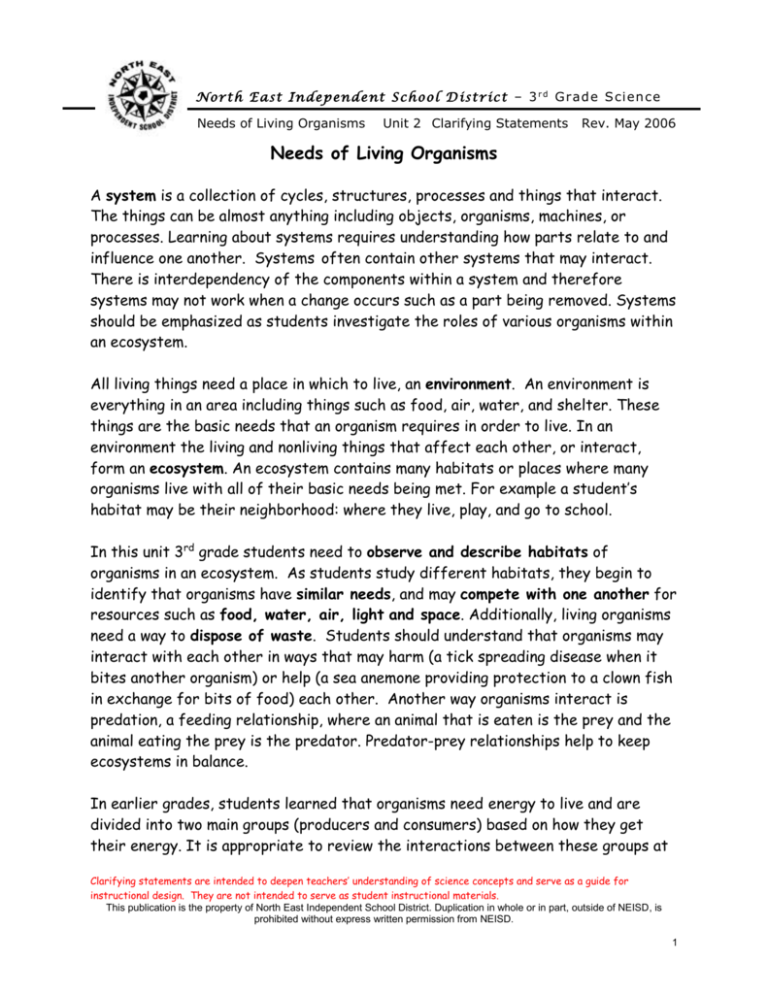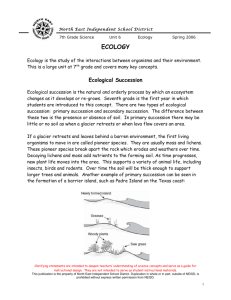Needs of Living Organisms
advertisement

N o r t h E a st I n d ep en d e nt S c h o o l D i st ric t – 3 r d G r ad e S ci en c e Needs of Living Organisms Unit 2 Clarifying Statements Rev. May 2006 Needs of Living Organisms A system is a collection of cycles, structures, processes and things that interact. The things can be almost anything including objects, organisms, machines, or processes. Learning about systems requires understanding how parts relate to and influence one another. Systems often contain other systems that may interact. There is interdependency of the components within a system and therefore systems may not work when a change occurs such as a part being removed. Systems should be emphasized as students investigate the roles of various organisms within an ecosystem. All living things need a place in which to live, an environment. An environment is everything in an area including things such as food, air, water, and shelter. These things are the basic needs that an organism requires in order to live. In an environment the living and nonliving things that affect each other, or interact, form an ecosystem. An ecosystem contains many habitats or places where many organisms live with all of their basic needs being met. For example a student’s habitat may be their neighborhood: where they live, play, and go to school. In this unit 3rd grade students need to observe and describe habitats of organisms in an ecosystem. As students study different habitats, they begin to identify that organisms have similar needs, and may compete with one another for resources such as food, water, air, light and space. Additionally, living organisms need a way to dispose of waste. Students should understand that organisms may interact with each other in ways that may harm (a tick spreading disease when it bites another organism) or help (a sea anemone providing protection to a clown fish in exchange for bits of food) each other. Another way organisms interact is predation, a feeding relationship, where an animal that is eaten is the prey and the animal eating the prey is the predator. Predator-prey relationships help to keep ecosystems in balance. In earlier grades, students learned that organisms need energy to live and are divided into two main groups (producers and consumers) based on how they get their energy. It is appropriate to review the interactions between these groups at Clarifying statements are intended to deepen teachers’ understanding of science concepts and serve as a guide for instructional design. They are not intended to serve as student instructional materials. This publication is the property of North East Independent School District. Duplication in whole or in part, outside of NEISD, is prohibited without express written permission from NEISD. 1 N o r t h E a st I n d ep en d e nt S c h o o l D i st ric t – 3 r d G r ad e S ci en c e Needs of Living Organisms Unit 2 Clarifying Statements Rev. May 2006 this time. Students need to recall that the movement of energy through an environment from one living thing to another forms a food chain. An ecosystem may have many food chains that overlap because most organisms are part of more than one food chain; therefore, the focus in this unit of study is on food webs. Food webs contain producers and consumers that are used as food by more than one living organism and show a more complete picture of the flow of energy in an ecosystem. Arrows in a food chain and a food web show the direction of the flow of energy and should always point away from the organism being consumed and toward the organism doing the consuming. Food Web Example Clarifying statements are intended to deepen teachers’ understanding of science concepts and serve as a guide for instructional design. They are not intended to serve as student instructional materials. This publication is the property of North East Independent School District. Duplication in whole or in part, outside of NEISD, is prohibited without express written permission from NEISD. 2 N o r t h E a st I n d ep en d e nt S c h o o l D i st ric t – 3 r d G r ad e S ci en c e Needs of Living Organisms Unit 2 Clarifying Statements Rev. May 2006 Students should understand that the source of energy in most ecosystems is the Sun. Because energy in an ecosystem begins with the Sun, producers are almost always the starting point of a food chain and a food web. Students may now begin to examine the survival needs of different organisms and conclude how conditions in particular habitats can limit what kind of living organisms can survive. For any particular environment, some kinds of plants and animals thrive (prosper), may become ill, or perish (die off.) Different species may live in the same habitat, but each one has a specific role. The interaction of these organisms, each with its specific role, is one factor that contributes to the overall health of the system. Environmental changes in an organism’s habitat are sometimes beneficial and sometimes harmful. Changes caused by nature such as storms and floods can kill organisms and destroy habitats. These changes can also bring a new rich layer of soil to a riverbank so that new plants can grow and fallen trees may provide a new home for some animals. Students should also gain understanding that organisms modify their environment to meet their needs. Some examples include birds building a nest, prairie dogs digging burrows, or spiders building a web. Sometimes one organism’s modification may be harmful to another organism. For example, factories run by humans can dump waste into water sources contaminating the water and killing organisms. In some cases, the destruction of habitats can cause a species to completely disappear. Clarifying statements are intended to deepen teachers’ understanding of science concepts and serve as a guide for instructional design. They are not intended to serve as student instructional materials. This publication is the property of North East Independent School District. Duplication in whole or in part, outside of NEISD, is prohibited without express written permission from NEISD. 3









